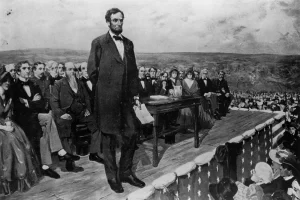The American Civil War was a significant conflict that took place in the United States from 1861 to 1865. It was primarily fought between the Northern states, known as the Union, and the Southern states, known as the Confederacy. The war emerged due to a complex interplay of political, economic, social, and cultural factors, with the central issue being slavery and its expansion into newly acquired territories.
WHAT CAUSED THE AMERICAN CIVIL WAR?
The American Civil War was caused by a combination of long-standing political, economic, social, and cultural factors, with the central and most contentious issue being slavery. Here are some of the key factors that led to the outbreak of the Civil War:
- Slavery: The institution of slavery was deeply entrenched in the Southern states’ agrarian economy. The North and South had contrasting views on the expansion of slavery into newly acquired territories. The South believed that their economic and social systems depended on slave labor, while many in the North opposed the spread of slavery and sought to contain its expansion.
- Sectionalism: Over time, the North and South developed distinct economies, societies, and cultures. This led to sectionalism, where people identified more with their region than with the nation as a whole. This divide was exacerbated by differences in economic interests, such as industry in the North and agriculture in the South.
- States’ Rights vs. Federal Authority: The issue of states’ rights versus federal authority was a recurring theme in American history leading up to the Civil War. Southern states argued that they had the right to secede from the Union if they felt their rights were being infringed upon. This dispute over the balance of power between states and the federal government played a role in the tensions that eventually led to war.
- Political Discord: The political landscape was fraught with conflict over slavery-related issues. The passage of the Kansas-Nebraska Act in 1854, which allowed territories to decide on the legality of slavery through popular sovereignty, led to violence in Kansas and further intensified tensions.
- Election of Abraham Lincoln: The election of Abraham Lincoln, a Republican who opposed the expansion of slavery, served as a catalyst for secession. Southern states felt that his election signaled a threat to their way of life and feared that his policies would lead to the eventual abolition of slavery.
- Economic Differences: The North and South had divergent economic interests. The North was becoming more industrialized, while the South relied heavily on agriculture, including cotton production. Economic disparities between the regions contributed to their differing views on issues such as tariffs and federal economic policies.
- Cultural and Social Differences: Slavery had profound cultural and social implications. Abolitionist movements in the North gained momentum, advocating for the immediate and complete end of slavery. The South, on the other hand, defended slavery as a fundamental part of their society and way of life.
- Compromises Failed: Previous attempts to reach compromises on the issue of slavery, such as the Missouri Compromise and the Compromise of 1850, had only temporarily eased tensions. As new territories were acquired and the question of whether they would allow slavery arose, these compromises became less effective.
All these factors converged to create a volatile atmosphere in which the secession of Southern states and the eventual outbreak of war became increasingly likely. While slavery was not the only factor in the Civil War, it was undoubtedly the most significant and divisive issue that ultimately led to the fracture of the United States and the eruption of armed conflict.
All these factors converged to create a volatile atmosphere in which the secession of Southern states and the eventual outbreak of war became increasingly likely. While slavery was not the only factor in the Civil War, it was undoubtedly the most significant and divisive issue that ultimately led to the fracture of the United States and the eruption of armed conflict.
WHAT WERE ABRAHAM LINCOLN’S CHEIF GOALS IN THE AMERICAN CIVIL WAR?
Abraham Lincoln’s chief goals during the American Civil War were centered around preserving the Union and ultimately ending the institution of slavery. These goals guided his leadership and decision-making throughout the conflict.
- Preserving the Union: Lincoln believed in the importance of maintaining the unity of the United States. He saw the secession of Southern states as a direct challenge to the principles of the nation and its democratic government. Throughout the war, Lincoln’s primary objective was to prevent the Confederate states from successfully seceding and to ensure that the United States remained intact.
-
Abolishing Slavery: While Lincoln initially focused on preserving the Union, his stance on slavery evolved over time. As the war progressed, he recognized that slavery was a fundamental issue fueling the conflict. In 1863, he issued the Emancipation Proclamation, which declared slaves in Confederate-held territories to be free. While this didn’t immediately free all slaves, it marked a significant step toward ending slavery and aligning the war’s purpose with the broader cause of human rights.
- Uniting the Nation: Lincoln aimed to heal the wounds of division and reconcile the North and South after the war. He understood that the nation would face significant challenges in reuniting and rebuilding after such a devastating conflict. His second inaugural address, delivered in 1865, reflects his emphasis on unity and his desire to bind up the nation’s wounds.
- Securing Civil Liberties: Despite the pressures of war, Lincoln was committed to upholding civil liberties and the Constitution. He faced criticism for some of his wartime policies, such as the suspension of habeas corpus, but he believed these actions were necessary to preserve the Union and ensure the safety of the nation.
Lincoln’s leadership during the Civil War demonstrated a careful balancing act between his dedication to preserving the Union, his evolving stance on slavery, and his commitment to democratic principles. His tragic assassination in 1865 marked the end of his direct involvement in shaping the post-war reconstruction period, but his legacy continued to shape the nation’s trajectory in the years that followed.

